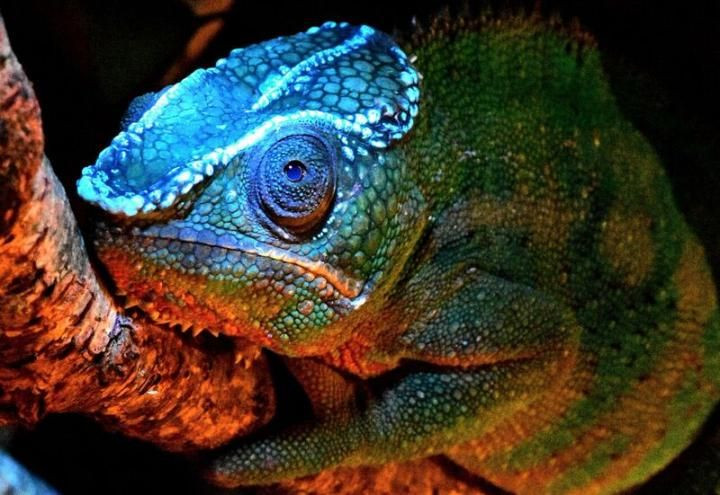Glowing Lizards: Chameleons Don’t Just Change Colors, Their Bones Are Fluorescent

Chameleons are known for their ability to change colors, something the lizards do chiefly to communicate with others of their kind (and not to avoid predators, as is commonly thought). But scientists have learnt that many chameleon species display another kind of coloration — fluorescence.
Biogenic fluorescence or bioluminescence is known to exist among a large number of marine animals, but is not at all common among terrestrial creatures. Chameleons are entirely land-living animals, and therefore the discovery of this trait among many species was quite a surprising find. In an open-access paper published Monday, German researchers said they found bony projections from chameleon skulls fluoresce under ultraviolet (UV) light.
“We could hardly believe our eyes when we illuminated the chameleons in our collection with a UV lamp, and almost all species showed blue, previously invisible patterns on the head, some even over the whole body,” David Prötzel, lead author of the new study and a Ph.D. student at the Bavarian State Collection of Zoology (ZSM), said in a statement.
The bone projections, called tubercles, absorb the UV light and then emit it as fluorescence. This is possible because the skin over the tubercles on the skull is extremely thin, effectively acting like an open window for the UV light to go through. The researchers looked into this after micro-CT scans showed an exact match between the patterns of fluorescence and the tubercles.
The skin of chameleons is made of multiple layers, with the top-most layer being transparent. The cells that change color are in the lower layers of the skin. So the fact that the skin over tubercles acts like a window is not entirely surprising, unlike the discovery itself.
“It has long been known that bones fluoresce under UV light, but that animals use this phenomenon to fluoresce themselves has surprised us and was previously unknown,” Frank Glaw, curator of herpetology at ZSM and coauthor of the study, said in the statement.
This attribute was widespread among chameleons in Madagascar and Africa, especially among genera living in forests. The humid forest habitat has relatively higher component of ambient UV light, and the fluorescence is emitted in blue color. The tubercles that fluoresce under UV light form in patterns that are distinct among species or genera. Among the genus Calumma, males of most species have a lot more tubercles than the females.
The contrast of blue against the predominantly green and brown forest background would make these fluorescent chameleons stand out, and while the researchers did not draw any specific conclusions about what that could mean, they said their “discovery opens new avenues in the study of signaling among chameleons and sexual selection factors driving ornamentation.”
In other words, the luminescence could be used by individual chameleons to identify other members of their own species, or even possibly even attracting potential mating partners.
Titled “Widespread bone-based fluorescence in chameleons,” the study appeared in the journal Scientific Reports.
© Copyright IBTimes 2025. All rights reserved.





















